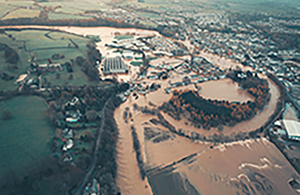Flood Forecasting Centre: the first 10 years
How the Flood Forecasting Centre forecasts future flooding and provides information and guidance.

In June and July 2007, the UK experienced devastating floods:
- approximately 55,000 homes affected
- 7,000 people had to be rescued
- 13 people lost their lives
Following the aftermath of this event, the government conducted an assessment termed the ‘Pitt Review’. This helped to see how flood prediction and the response to flooding could be improved for the future.
The review highlighted the need for stronger collaboration between the Environment Agency and the Met Office. A joint a body called the Flood Forecasting Centre (FFC) was born.
The Flood Guidance Statement - the FFC’s first product
One of the first services the FFC set up was regular Flood Guidance Statements. These provide advice and information to the responder community on the risk of flooding for 5 days ahead. The statements show the risk in a simple colour-coded system. This makes them easy for emergency responders to read.
The Flood Guidance Statement in action
During the first operational year for the FFC, there were 2 major flood events in the north of England, both forecast ahead of time. Cumbrian authorities were able to use the information provided in the forecast to take action and evacuate households 36 hours before the floodwaters hit.
The Chief Executive of the Environment Agency at that time commented, saying “A big thank you to the Flood Forecasting Centre who were able to indicate this well before it was obvious to the operational staff.”
By 2010, the FFC had become recognised as a permanent part of the emergency response framework. Members of the public could also view the forecasts on the Environment Agency website. In November 2012, 180,000 people visited the website to see the flooding forecast.
Part of the national response
Year after year, the FFC’s forecasts have made a big difference to flood preparation and to people’s lives. The Flood Guidance Statements are created with the input of information from:
- Environment Agency local forecasting teams
- Natural Resources Wales
Emergency services have used these since the FFC was set up in 2009. The service has become essential to flood preparation. The FFC is now invited to attend high level government meetings focused on flooding. At these meetings the FFC brief ministers and even the prime minister.
The Flood Guidance Statement and flood barriers
In 2016, 40 kilometres of temporary barriers were placed in locations across the UK to help reduce flood risk. This shows how much faith is placed in the accuracy and value of the guidance produced by the FFC. These barriers were used in Bridgwater, Somerset in 2016 and helped protect housing from flooding. An emergency responder commented on the work of the FFC “If you forecast it, it happened.”
The FFC - always improving its service
Since 2009 the Flood Guidance Statements have become more complex. They now include information on all 4 natural sources of flooding:
- coastal
- surface water
- groundwater
- river flooding
The FFC has also introduced new services:
- the coastal decider tool - forecasts the risk of coastal flooding up to 15 days ahead
- the monthly Flood Outlook product
The future of the FFC
Looking ahead, climate change is likely to increase the duration and intensity of flood risk. The services provided by the FFC will evolve to mitigate these challenges. For example, using improved supercomputing power to increase the accuracy of forecasts.